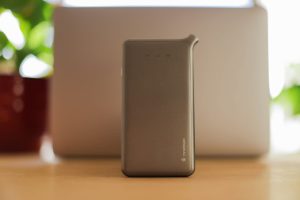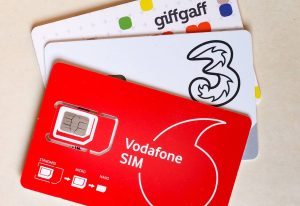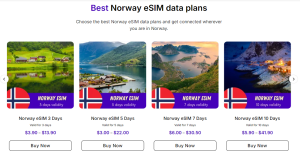Wanting to have a trip to Norway but don’t know how to stay connected? This article compares three popular options for internet access while traveling: Pocket WiFi, SIM cards, and data roaming. We’ll break down the pros and cons of each method to help you choose the best option for your Norwegian adventure.
I. Pocket wifi

Pocket WiFi offers a portable internet solution that allows you to connect multiple devices while exploring Norway.
What is Pocket Wifi
Pocket WiFi is a tiny gadget you can carry around that gives you internet anywhere. It uses cell phone networks to make a WiFi hotspot just for you. This lets you connect your phone, computer, or tablet to the internet no matter where you go.
Advantages of Pocket Wifi
- Always connected: Internet access anywhere with mobile coverage
- Multiple devices: Connect several gadgets at once
- Cost-effective: Often cheaper than roaming charges when traveling
- Easy to use: You only need to turn the pocket wifi on and connect
- Secure: More private than public WiFi hotspots
- Shareable: Friends or family can also use your connection
Disadvantages of Pocket Wifi
- Limited coverage: Depends on mobile network availability
- Data caps: Users might encounter usage limits or slower speeds after a certain amount
- Battery life: Needs regular charging, especially with heavy use
- Rental fees: Can be expensive if renting for short trips
- Setup required: Need to configure devices to use it initially
Price of Pocket Wifi in Norway
The cost of renting a pocket WiFi in Norway varies depending on different providers, the table below summarizes the cost and features of renting a pocket WiFi in Norway.
| Provider | Data Plan | Price per Day ($) | Data Limit | Number of Devices | Additional Notes |
| Wifivox | 1 GB/day | $7.65 | 1 GB at max speed, then reduced | Up to 5 devices | Offers higher plans (5 GB/day for $8.75
, 10 GB/day for $12.05) |
| Hippocketwifi | Unlimited | $7.59
– $10.89 |
Unlimited | Multiple devices | Price varies depending on rental period |
| XOXO WiFi | Unlimited | Approx. 7 | Unlimited | Multiple devices | Device delivered before trip; easy return process |
Note: Please note that these figures are approximate. Your actual costs may be quite different based on your specific service plan and how you use your device.
Suitable for
Based on the advantages and disadvantages of pocket wifi, it is suitable for visitors who are:
- Short-term travelers: Ideal for those visiting a country for days or weeks, not months.
- People needing occasional mobile internet: Good for those who don’t need constant access but want it sometimes when out.
- Those who can’t or don’t want to rely on public WiFi: Suitable for people concerned about security or inconsistent public hotspots.
II. Tourist SIM card

A local Norway SIM card provides you with a temporary local number and data plan for your stay in the country.
A tourist SIM card is a temporary mobile card, which gives you a local number and data at local rates, which is usually cheaper than using your home plan abroad. These cards typically last for a short time and come with a set amount of data, calls, and texts. It’s a simple way to stay connected while traveling without high roaming costs.
Advantages and Disadvantages of SIM Cards in Norway
Before you buy a SIM Card in Norway, you should know its advantages and disadvantages first:
| Advantages | Disadvantages |
| – Easy to swap between phones
– Widely supported by most devices – No internet needed to set up |
– Can be lost or damaged
– Limited storage for contacts – Need a special tray and tool to put in a SIM card |
Price of SIM Cards in Norway
There are many SIM Card plans from many providers, here is a table comparing some plans:
| Provider | Data Plan | Price (NOK/USD) | Validity | Notes |
| Telenor | 10GB | 199 NOK (~$20 USD) | 30 days | Physical SIM; extensive coverage across Norway |
| Unlimited annual | 1599 NOK (~$150 USD) | 1 year | ||
| Telia | 15GB | 199 NOK (~$20 USD) | 30 days | Physical SIM; good coverage, especially in urban areas |
| Unlimited (3 months) | 999 NOK (~$100 USD) | 3 months | ||
| ICE | 6GB | 99 NOK (~$10 USD) | 30 days | Physical SIM; affordable, good for short stays |
| Unlimited (90 days) | 699 NOK (~$70 USD) | 90 days |
Note: Your real charges may be higher or lower depending on your exact plan and how much data you use, to get precise information about potential costs, it’s important to check with your mobile carrier.
SIM Card in Norway Suitable For
- Physical SIM Cards are suitable for:
- Travelers with older or basic phones that do not support eSIM technology.
- Users needing extensive local support or those unfamiliar with digital processes.
However, due to many disadvantages of physical SIM Cards that were mentioned above, using a SIM Card in Norway might not be the best option. But thanks to the technology development, the advent of Norway eSIM is a better alternative for visitors.
Here are some benefits of using a Norway eSIM:
- No physical card to handle or lose
- eSIM support multiple profiles on one device
- eSIM can be activated remotely before travel
- Often simpler to set up
You can easily find Norway eSIM from many reliable providers such as norwayesim.com, gigago.com, Airalo, aloSIM, OneCall, Telenor, etc.
Among the providers mentioned, norwayesim.com offered the smoothest experience with reasonable data plans and other special features:
- 24/7 customer support
- Set up Norway eSIM through QR code scanning
- Support many payment methods including credit/debit cards and PayPal
- Receive the eSIM via email within 5 minutes after purchase
- Can share phone internet with other devices
- Can share phone internet with other devices
III. Data roaming in Norway

Data roaming in Norway lets you use your home country’s mobile plan while in the country, offering familiarity but potentially at a higher cost.
What is Data Roaming
Data roaming is when your phone uses a mobile network outside your home country to access the internet, make calls, or send texts. Data roaming allows you to stay connected even when you’re not using your usual network.
| Feature | Advantages | Disadvantages |
|---|---|---|
| Stay Connected | Use your phone for calls, texts, and internet abroad | Can lead to expensive phone bills |
| No Extra SIM Needed | Phone works as it does at home | Easy to accidentally use data |
| Convenience | Automatic connection, no setup required | May experience slower or less reliable service |
Price of Data Roaming in Norway
Understanding the cost of data roaming is very important for budget planning. Here’s a general comparison of estimated roaming charges from many US carriers:
| Carrier | Plan | Price | Data Allowance | Call Charges | Text Charges | Notes |
| AT&T | International Day Pass | $12 per day | Uses domestic plan data | Free for calls to/from the U.S. | Free for texts to/from the U.S. | Additional lines cost $6/day; no extra charge after 10 days per billing cycle. |
| Verizon | TravelPass | $10 per day | Uses domestic plan data; throttled after 0.5GB | Unlimited calls within included countries | Unlimited texts | Charges apply only when used; pay-as-you-go rates can be high. |
| T-Mobile | Go5G | $80 per month | Unlimited data at 256Kbps | $0.25 per minute | Unlimited texts | Upgrade to Go5G Plus for additional features. |
Note: Please note that these figures are approximate. Your actual costs may be quite different based on your specific service plan and how you use your device.
Data Roaming in Norway suitable for
Because of its expensive price, data roaming in Norway is suitable for short-term tourists (1-3 days) because it is convenient, no setup required, just activate and go. However, if you are planning to stay longer, consider other ways to stay connected.
IV. Final thoughts
In conclusion, Pocket Wifi, SIM Card, and Data Roaming are all good ways to stay connected. However, each has its own advantages and disadvantages, that’s why it’s important to consider each option carefully. Additionally, eSIM is also a great alternative that should be taken into account for your trip. Wish you a fantastic time in Norway!
